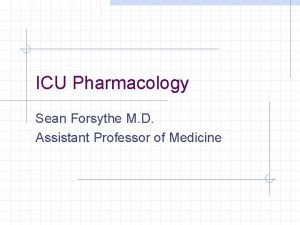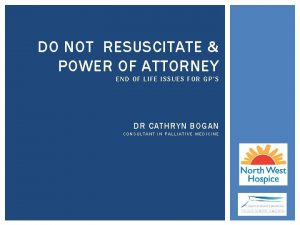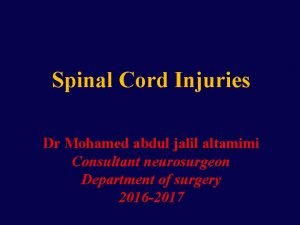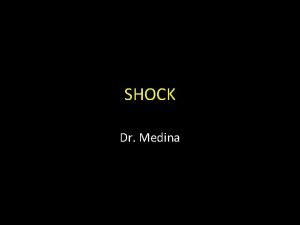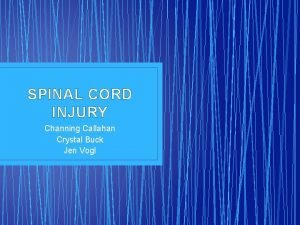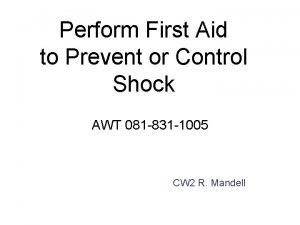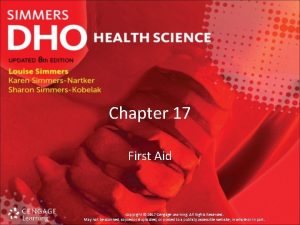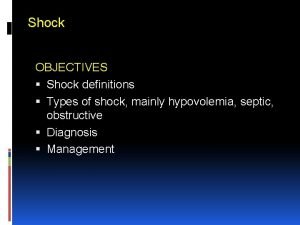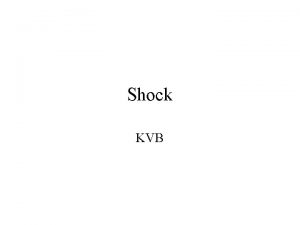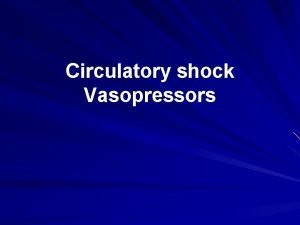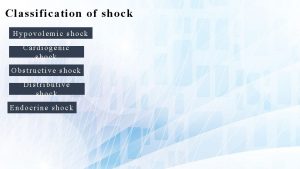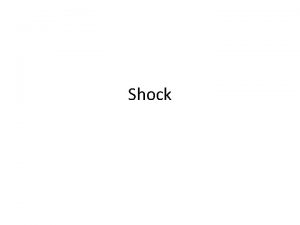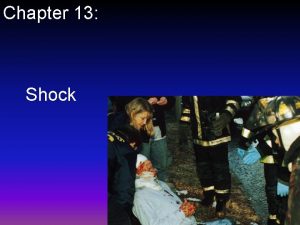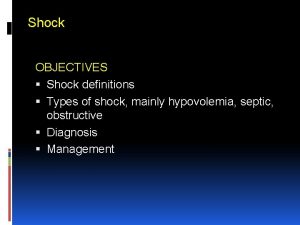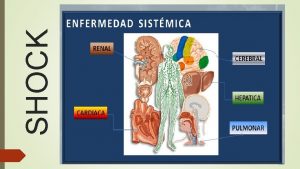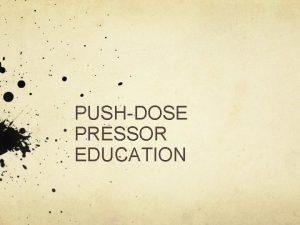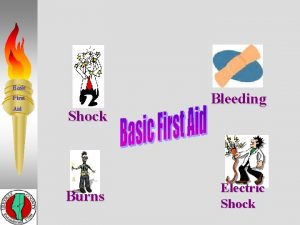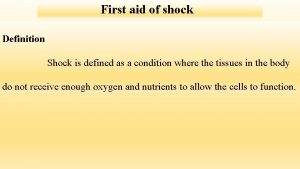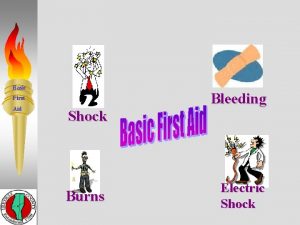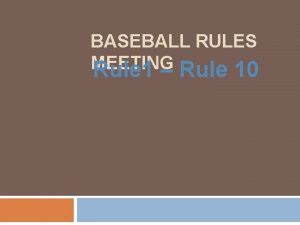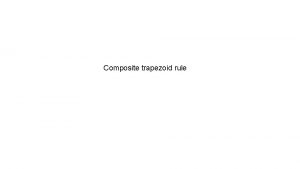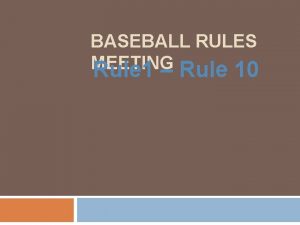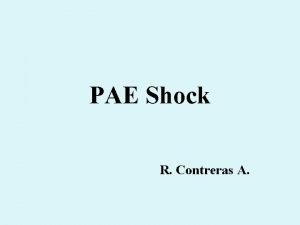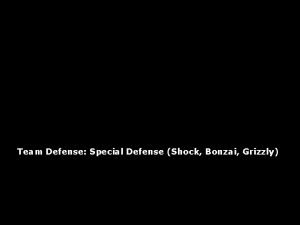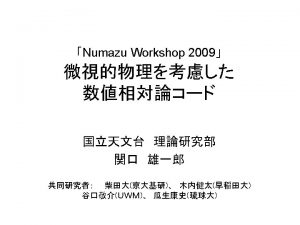SHOCK PRESSORS Dr H FIRST RULE RESUSCITATE THE


























- Slides: 26

SHOCK & PRESSORS Dr H

FIRST RULE RESUSCITATE THE PATIENT

SECOND RULE TREAT THE PATIENT Maximal Dosing is Arbitrary Patients often have multiple types of shock at play -For example, a septic patient will have vasodilatory shock and possibly cardiogenic from cytokineinduced cardiomyopathy -Consider multiple types of pressors if your evaluation warrants such

What Is Blood Pressure? Function of: HR CO SV Myocardial contractility Preload Afterload SVR (GOAL MAP >60/65)

Types of Shock Standl et al. The Nomenclature, Definition and Distinction of Types of Shock. Dtsch Arztebl Int 2018; 115: 757 -68.

Hypovolemic Shock Hypovolemic without Hemorrhage Crystalloids Hemorrhage Blood Products Traumatic Hemorrhage Control bleeding Blood Products Norepinephrine if needed

Distributive Loss of regulation of vascular tone volume being shifted within the vascular system disordered permeability of the vascular system shifting of intravascular volume into the interstitium

Septic dysregulated response to infection Antibiotics (EARLY) Crystalloids (30 m. L/kg bolus) Goal MAP >65 Norepinephrine Vasopression "as a norepinephrine sparing measure"

Anaphylactic massive histamine-mediated vasodilation Epineprhine (sometimes norepinephrine gtt) Steroids (will take about 6 hours to fully kick in) Anti-histamines (diphenhydramine & famotidine) Crystalloids

Neurogenic imbalance between sympathetic and parasympathetic regulation of cardiac action and vascular smooth muscle Standl et al. The Nomenclature, Definition and Distinction of Types of Shock. Dtsch Arztebl Int 2018; 115: 757 -68.

Neurogenic Crystalloids Goal MAP >85 Norepinephrine Mineralcorticoids

Cardiogenic May be due to myocardial, rhythmologic, or mechanical causes Treatment clearly depends on cause May include Reperfusion Pacemaker Placement Valve Repair Ablation Balloon Pump Ventricular Device Placement Drugs: pressors, inotropes, calcium sensitizers, PDE 3 i

Obstructive obstruction of the great vessels or the heart itself Treat Underlying Cause Vena Caval Compression Tension Pneumothroax Pericardial Tamponade PE Intracardial Mass

A Word On Dosing Hospitals will vary on WB (weight based) and NWB (nonweight based) dosing Studies have identified that morbidly obese patients likely don't require weightbased doses Given the arbitrariness of maximal dosing, simply be familiar with your hospital protocols For example, even the FDA has no "upper limit" for norepinephrine. They simply state: "In all cases, dosage of LEVOPHED should be titrated according to the response of the patient. Occasionally much larger or even enormous daily doses (as high as 68 mg base or 17 vials) may be necessary if the patient remains hypotensive"

Receptors Dopamine (DA 1 & DA 2) Complicated actions within coronary, mesenteric & renal beds Alpha (α 1 -adrenergic) Arterial vasoconstriction Ubiquitous within smooth muscle of arterial walls Beta (β 1 -adrenergic) Increased cardiac contractility and heart rate Cardiac smooth muscle acting on sinoatrial node to produce chronotropy acting on atrial&ventricular muscle to produce inotropy Vasopressin (V 1) Vasoconstriction, ADH/Prolactic Release, Renal Water Reabsorption Lie within vascular smooth muscle, ant pituitary, and renal collecting duct

Drugs WB Norepinephrine Start @ 0. 2 mcg/kg/min max 3 mcg/kg/min Epinephrine Start @ 0. 1 mcg/kg/min max 1. 0 mcg/kg/min Vasopressin 0. 04 units/min (on or off, no titration) Phenylephrine Start @ 0. 5 mcg/kg/min max 10 mcg/kg/min Dopamine Start @ 5 mcg/kg/min max 20 mcg/kg/min Dobutamine Start @ 2. 5 mcg/kg/min max 20 mcg/kg/min 40 mcg/kg/min used in stress tests

Drugs NWB Norepinephrine Start @ 5 mcg/min max 30 -40 mcg/min Epinephrine Start @ 5 mcg/min max 40 mcg/min Vasopressin 0. 04 units/min (on or off, no titration) Phenylephrine Start @ 40 mcg/min max 200 mcg/min Dopamine & Dobutamine are not usually dosed in a NWB format

Norepinephrine 1 ST CHOICE GTT in ALL TYPES OF SHOCK Increased SVR; little or no change in CO Combined α and β (α > β) Start @ 0. 2 mcg/kg/min max 3 mcg/kg/min 5 mcg/min max 30 -40 mcg/min Excessive peripheral vasoconstriction can lead to lactic acidosis, ischemia/necrosis

Epinephrine ANAPHYLACTIC Increases SV and CI, modest increases in SVR & HR Combined α and β Start @ 0. 1 mcg/kg/min max 1. 0 mcg/kg/min 5 mcg/min max 40 mcg/min Excessive peripheral vasoconstriction can lead to lactic acidosis, ischemia/necrosis

Vasopressin ADD TO NOREPINEPHRINE IN SEPTIC SHOCK Endogenous hormone from posterior pituitary Deficiency in septic shock Dose: 0. 01 – 0. 06 units/min V 1 receptors on vascular smooth muscle = vasoconstriction

Phenylephrine Good for pts in which other drugs’ SE profile, i. e. tachyarrthymias, limits their use Pure α 1 Increased SVR Start @ 0. 5 mcg/kg/min max 10 mcg/kg/min 40 mcg/min max 200 mcg/min Excessive peripheral vasoconstriction can lead to lactic acidosis, ischemia/necrosis Careful use in cardiac patients – increase in SVR & MAP without change in HR leads to decreased CO and will cause coronary vasoconstriction

A Word on Extravasation IMPORTANT — Antidote for Extravasation Ischemia: To prevent sloughing and necrosis in areas in which extravasation has taken place, the area should be infiltrated as soon as possible with 10 m. L to 15 m. L of saline solution containing from 5 mg to 10 mg of Regitine® (brand of phentolamine), an adrenergic blocking agent. A syringe with a fine hypodermic needle should be used, with the solution being infiltrated liberally throughout the area, which is easily identified by its cold, hard, and pallid appearance. Sympathetic blockade with phentolamine causes immediate and conspicuous local hyperemic changes if the area is infiltrated within 12 hours. Therefore, phentolamine should be given as soon as possible after the extravasation is noted

Dopamine CONSIDER IF THERE IS NEED FOR INOTROPIC SUPPORT ↑ Stroke Volume (thereby ↑ MAP & CO) Dose-related receptor activity “Renal dose dopamine” doesn’t exist DA: 1 -3 mcg/kg/min β 1: 3 -10 mcg/kg/min α 1: 10 -20 mcg/kg/min Major SE: Tachyarrhythmias Other SE: Increase in PCWP and pulmonary shunting, May cause poor splanchnic perfusion

Dobutamine NEED FOR INTOTROPE β 1 – strong inotropic activity Increased contractility leads to decreased SVR (sometimes called “inodilator”) - will often need to use with norepinephrine Start @ 2. 5 mcg/kg/min max 20 mcg/kg/min SE: Tachydysrhythmias Isoproterenol is a pure beta-agonist and a powerful chronotrope dosed at 2 -10 mcg/min - many hospitals don't carry it

Midodrine "Oral Phenylephrine" Used in OP setting particularly for pts who develop hypotension with dialysis Can be used in the hospital to liberate from IV vasopressors Is a component of therapy for hepatorenal syndrome

Miscellaneous Drugs • Methylene Blue 1. 5 to 2 mg/kg over 20 to 60 minutes administered once • Restore Vasoplegia after Cardiac Surgery (through e. NOS) • Milrinone 0. 375 -0. 75 mcg/kg/min • PDE 3 i increasing c. AMP • Causes increased myocardial contractility & vasodilation • Levosimendan 6 to 12 mcg/kg infused over 10 minutes. Maintenance: 0. 05 to 0. 2 mcg/kg/minute • "Calcium Sensitizer" • Enhances ventricular contractility & vasodilation • Angiotensin II 10 to 80 ng/kg/minute • Works at AT 1 and AT 2 G-coupled protein receptors to vasoconstrict and release aldosterone and vasopressin
 Sean forsythe
Sean forsythe Power of attorney do not resuscitate form
Power of attorney do not resuscitate form Resuscitate
Resuscitate Cauda equina vs conus medullaris
Cauda equina vs conus medullaris Normovolemico
Normovolemico Spinal shock vs neurogenic shock
Spinal shock vs neurogenic shock T10 spinal cord
T10 spinal cord Subacute combined degeneration
Subacute combined degeneration Unit 15:3 providing first aid for bleeding and wounds
Unit 15:3 providing first aid for bleeding and wounds Chapter 17:3 providing first aid for bleeding and wounds
Chapter 17:3 providing first aid for bleeding and wounds Perform first aid to prevent or control shock
Perform first aid to prevent or control shock Chapter 17:7 providing first aid for heat exposure
Chapter 17:7 providing first aid for heat exposure Hình ảnh bộ gõ cơ thể búng tay
Hình ảnh bộ gõ cơ thể búng tay Lp html
Lp html Bổ thể
Bổ thể Tỉ lệ cơ thể trẻ em
Tỉ lệ cơ thể trẻ em Voi kéo gỗ như thế nào
Voi kéo gỗ như thế nào Glasgow thang điểm
Glasgow thang điểm Bài hát chúa yêu trần thế alleluia
Bài hát chúa yêu trần thế alleluia Kể tên các môn thể thao
Kể tên các môn thể thao Thế nào là hệ số cao nhất
Thế nào là hệ số cao nhất Các châu lục và đại dương trên thế giới
Các châu lục và đại dương trên thế giới Công thức tiính động năng
Công thức tiính động năng Trời xanh đây là của chúng ta thể thơ
Trời xanh đây là của chúng ta thể thơ Cách giải mật thư tọa độ
Cách giải mật thư tọa độ Phép trừ bù
Phép trừ bù Phản ứng thế ankan
Phản ứng thế ankan
